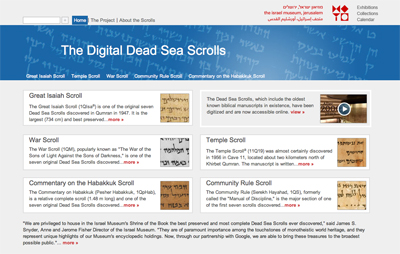
DAVID ADAMS reports…
Five of the Dead Sea Scrolls are now available to be viewed online under a partnership between the Israel Museum and technology giant Google.
 |
|
ONLINE LIBRARY: The Digital Dead Sea Scrolls website where high resolution versions of five scrolls can be viewed online. THE FIVE SCROLLS
|
The Dead Sea Scrolls Digital Project allows anyone to access high resolution images of the scrolls, providing the chance to see them in a higher level of detail that previously possible.
The Dead Sea Scrolls, which include the oldest known Biblical manuscripts in existence, date from the third century BCE to the first century CE. The first seven of the scrolls were discovered in a cave on the north-western shore of the Dead Sea by Bedouins in 1947.
Further finds followed and between 1947 and 1956, fragments of as many as 950 different scrolls were located in 11 caves. The richest yield, found in cave four, consisted of 15,000 fragments.
The scrolls are believed to have been the creation of an isolated Jewish sect, referred to in the scrolls as “the Community”, which settled in Qumran in the Judean desert.
The first seven scrolls have been housed at the Israel Museum in Jerusalem since 1965 where they are exhibited in the specially constructed Shrine of the Book. The majority of the other fragments are in the care of the Israel Antiquities Authority.
The first five scrolls to be digitized include the Great Isaiah Scroll, the Community Rule Scroll, the Commentary on Habbakuk Scroll, the Temple Scroll and the War Scroll.
The images of the scrolls – which were taken using technology to minimise the damage to what are fragile manuscripts – are almost 200 times higher resolution than those produced by a standard camera meaning details normally invisible to the naked eye can be seen.
Under the partnership with Google, internet searches for the scrolls will take people directly to the images. The Great Isaiah Scroll, meanwhile, can also be searched by column, chapter and verse and is accompanied by an English translation tool as well as an option for people to submit translations of verses in their own language.
The museum’s director, James S Snyder, says the scrolls are of “paramount importance among the touchstones of monotheistic world heritage and represent unique highlights of our museum’s encyclopedic holdings”.
Professor Yossi Matias, managing director of Google’s research and development center in Israel, adds that the project “enriches and preserves an important part of world heritage by making it accessible to all on the internet.”
“Having been involved in similar projects in the past including the Google Art Project, Yad Vashem Holocaust Collection, and the Prado Museum in Madrid, we have seen how people around the world can enhance their knowledge and understanding of key historical events by accessing documents and collections online.”
He says it is hoped additional Dead Sea Scroll documents will be put online at a later date.
To see the scrolls, head to http://dss.collections.imj.org.il.





